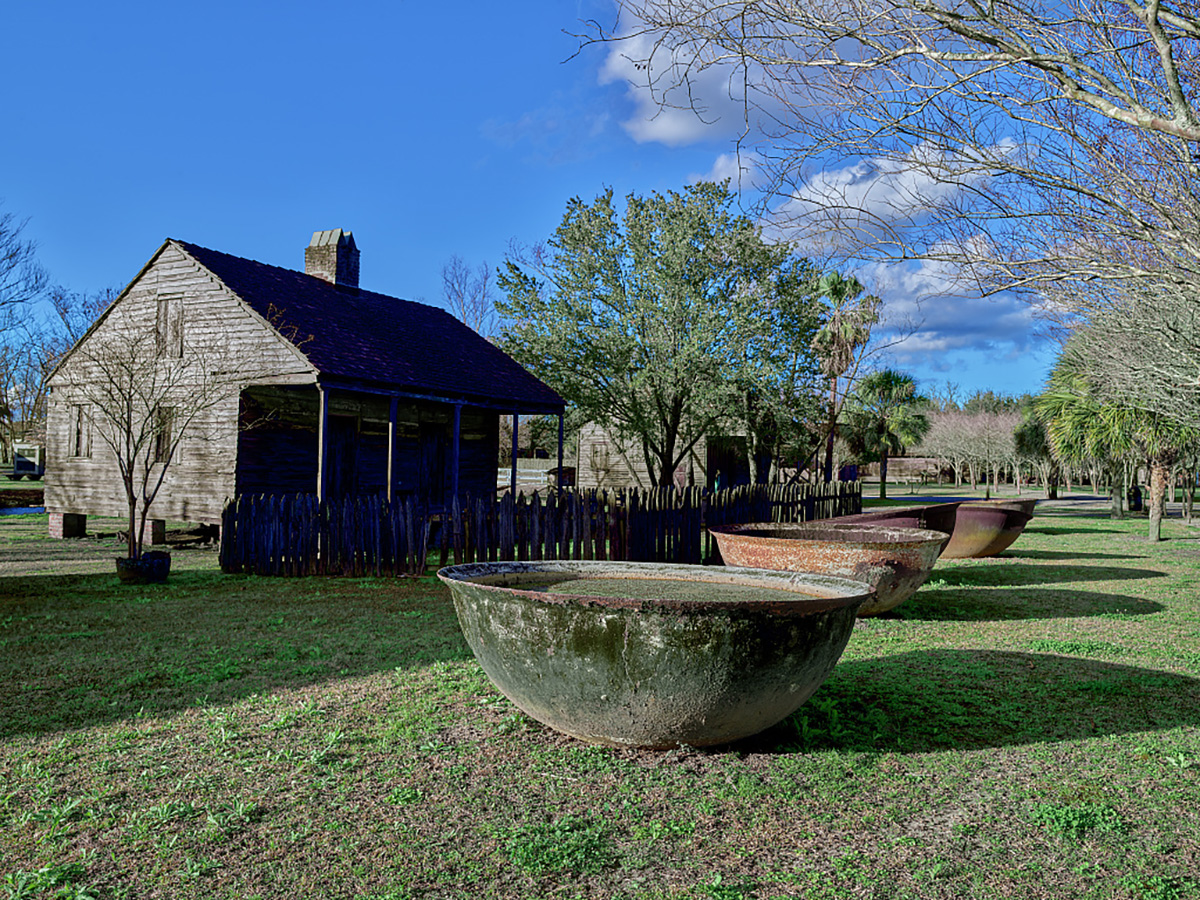Plantation Slavery in Antebellum Louisiana
During the antebellum period, Louisiana relied on the forced labor of enslaved people to work sugar and cotton plantations.
This entry is 7th Grade level View Full Entry

Carol M. Highsmith via Library of Congress Prints and Photographs Division
Enslaved peoples' cabins and sugarcane boiling kettles at Whitney Plantation, 2021.
Editor’s note: This entry contains graphic imagery.
The antebellum period refers to the decades prior to the outbreak of the American Civil War in 1861. It was a period of tremendous economic growth for Louisiana and the nation. The era was also marked by extreme violence and inequality. During this period Louisiana’s economic, social, political, and cultural makeup were shaped by the plantation system and the enslaved people upon which plantations relied.
How were Louisiana’s economy and the plantation system transformed by inventions?
In 1795 Étienne de Boré’s enslaved workforce produced Louisiana’s first commercially successful crop of granulated sugar under the guidance of a skilled free Black chemist named Antoine Morin. American inventors were also developing mechanized cotton gins around the same time, the most famous of which was patented by Eli Whitney in 1794. These machines, which removed cottonseeds from cotton fibers faster than by hand, dramatically increased the profitability of cotton farming, enabling large-scale cotton production in the Mississippi River valley.
Louisiana experienced an economic revolution when sugarcane and cotton were introduced at roughly the same time. Prospective planters flooded into the territory, creating sugar and cotton plantations from the area’s rich, river-fed soils. To provide labor for cotton and sugar plantations, slave traders began purchasing enslaved people from the Upper South (Virginia, Maryland, and North Carolina), where demand for enslaved people was falling, and reselling them in the Lower South (Louisiana, Georgia, Alabama, Mississippi, and Texas), where demand was soaring. By 1860 more than 124,000 enslaved Africans and African Americans had been forcibly brought to Louisiana by this domestic slave trade, destroying countless families while transforming New Orleans into the nation’s largest market for enslaved people. Louisiana’s enslaved population exploded: from fewer than 20,000 enslaved individuals in 1795 to more than 168,000 in 1840 and more than 331,000 in 1860.
By 1860 about one-sixth of the cotton and nearly all the sugar grown in the US were grown in Louisiana. Louisiana’s more than twenty-two thousand slaveholders were among the wealthiest in the nation. Overall the state boasted the second highest per-capita wealth in the nation, after Mississippi. Louisiana’s economy, politics, and social structure were defined by sugar and cotton, and the enslaved labor used to produce them.
What were working conditions like for enslaved people on sugar plantations?
The sugarcane plant requires ample moisture and a long, frost-free growing season. Due to these needs, it was only commercially grown in Louisiana’s southernmost parishes, below Alexandria. During January and February, enslaved people planted the cane. The spring and early summer were devoted to weeding. Throughout the year enslaved people also took care of drainage canals and levees, cleared brush, spread fertilizer, cut and hauled timber, repaired roads, harvested hay for livestock, grew their own food, and performed all the other back-breaking tasks that enabled cash-crop agriculture.
During late summer and autumn, the entire plantation prepared for the most physically difficult phase of the annual cycle—harvesting and grinding the raw sugarcane before the first frost destroyed the entire crop. In the months of October and December enslaved people cut the cane, fed it into grinding mills, and boiled the extracted sugar juice in massive kettles over roaring furnaces. Once it crystalized the granulated sugar was packed into massive wooden barrels known as hogsheads, each containing one thousand or more pounds of sugar, for transport to New Orleans. Then the cycle began again.
Sugarcane cultivation was brutal, even by the standards of American slavery. Workplace accidents were common: enslaved people were cut by cane knives, dragged into mills and crushed between grinders, mauled by boiler explosions, or burned by boiling juice. “It was a rare thing if a man lived from more than ten to twelve years of those who worked at the mill,” one formerly enslaved person recalled. In Louisiana’s sugar parishes, death rates were higher than birth rates. Enslaved women were simply too overworked, exhausted, and vulnerable to disease to bear healthy children. To replace those who died, sugar plantation owners continuously purchased more enslaved people, primarily young men. This dynamic meant that there were relatively few children in sugar country, and over two-thirds of enslaved people were men.
In addition to high costs and financial risks, sugar cultivation provided slaveholders with the opportunity to make large profits. As such, the sugar parishes tended toward particularly massive plantations, large populations of enslaved people, and extreme concentrations of wealth. On the eve of the Civil War, the average Louisiana sugar plantation was valued at roughly $200,000 ($7 million in 2023) and yielded a 10 percent annual return. It held roughly fifty people in bondage compared to the national average plantation population, which was closer to ten. Louisiana had the most expensive farms of any US state because slaveholders in the sugar parishes invested so much money in farm equipment. Only about 10 percent of Louisiana’s seventeen thousand farms produced sugar in 1860. Despite this, the farms reported owning $19 million in agriculture equipment (over $635 million in 2023). By comparison Wisconsin’s seventy thousand farms reported less than $6 million.
A small group of roughly five hundred elite sugar tycoons dominated the entire industry. Their ranks included many of the nation’s wealthiest slaveholders. John Burnside, Louisiana’s richest planter, enslaved 753 people in Ascension Parish and another 187 people in St. James Parish. In 1860 his total estate was valued at $2.2 million (roughly $78 million in 2023). Mary Stirling, Louisiana’s wealthiest woman, enslaved 338 people in Pointe Coupée Parish and another 127 in West Feliciana Parish. Her estate was valued at $590,500 (roughly $21 million in 2023).
What were working conditions like for enslaved people on cotton plantations?
Cotton production has lower overhead costs, less financial risk, and modest profits compared to sugarcane. The average Louisiana cotton plantation was valued at roughly $100,000, yielding a 7 percent annual return. Cotton flourished north of sugar country, particularly in the plains flanking the Red and Mississippi Rivers.
Enslaved people planted cotton in March and April. In August picking began and continued throughout the fall and early winter. During picking season, slaveholders forced the entire enslaved population—including young children, pregnant women, and the elderly—to harvest the crop. The skill level of cotton pickers varied, and dexterity was required. Enslaved Louisianans picked one hundred fifty pounds of cotton per day on average, but highly skilled workers could pick as much as four hundred pounds. Each haul was weighed and recorded before being fed through the cotton gin. Giant screw presses pressed the cotton lint into four-hundred-pound bales, which were shipped to New Orleans for export.
How did the plantation system affect the lives of enslaved people?
Sugar and cotton plantations used advanced management strategies to enforce ruthless efficiency on enslaved people. Field labor was typically organized into “gang systems,” with enslaved people performing coordinated, monotonous work under the strict supervision of an overseer, who maintained pace, rhythm, and synchronization. On large plantations, multiple gangs often worked together, drilling holes for seeds, dropping the seeds, and closing the holes in succession as if they were assembly lines. A large plantation also supported enslaved specialists: enslaved foremen and drivers who managed menial workers, as well as skilled artisans such as blacksmiths, carpenters, coopers, and spinners.
Slaveholders used violence alongside other coercive management strategies to maintain control and maximize profit. Those who submitted to authority or exceeded their work quotas received extra clothing, payment, food, and liquor. By inflicting pain and emotional trauma, these incentives were counterbalanced. In addition to regular whippings, enslavers subjected the enslaved to other forms of bodily harm, public humiliation, imprisonment, and family separation. Various methods, both physical and mental, were used to torture enslaved individuals to get them to conform and work long hours.
Plantation owners spent a remarkably low amount on feeding, clothing, and housing enslaved Louisianans. In 1830 the Louisiana Supreme Court estimated the cost of clothing and feeding an enslaved child “up to the time they become useful” at less than fifteen dollars (about $500 in 2023). In 1844 the cost of feeding an enslaved adult for one year was estimated at thirty dollars (about $1,000 in 2023). Typically the enslaved plantation worker received a clothing allotment twice a year that included two shirts, two pants or dresses, and one pair of shoes. Pork and cornmeal rations were allocated weekly. To supplement these inadequate rations, enslaved workers hunted, fished, and grew vegetables on their plantation plots.
Family, and the emotional nourishment it provided, were among the most valuable survival resources available to enslaved plantation workers. Most sought to maintain nuclear households, though the threat of forced family separation through sale always loomed. In antebellum Louisiana roughly half of all enslaved plantation workers lived in two-parent families, while roughly three-fourths lived in either single-parent or two-parent households. On large plantations enslaved families typically lived in rows of raised, wooden cabins, each consisting of two rooms, with one family occupying each room. Whenever possible, enslaved Louisianans separated the space with old blankets or spare wood to create privacy.
How did small-scale farming compare to a large plantation system?
While elite planters controlled the most productive agricultural lands, Louisiana was also home to many smaller farms. Approximately 15 percent of people enslaved in Louisiana lived on small family farms holding fewer than ten people. Unlike those living on large plantations, enslaved people on smaller farms worked alongside their owners, their families, and any hired enslaved workers or wageworkers. These farms grew various combinations of cotton, tobacco, grains, and food crops. Cattle rearing dominated the Attakapas region, an area in southwest Louisiana now known as Acadiana.
In what ways did enslaved people fight against conditions on plantations?
The most common and visible way that enslaved people resisted plantation conditions was by running away. Fugitives found refuge in the state’s remote swamps and woods, a practice known as marronage. For days, months, or even years, maroons lived in relative freedom by hunting, foraging, and stealing from neighboring plantations. Though usually temporary, the practice provided the maroon with an invaluable space to care for their psychological well-being, reestablish a sense of independence, and forge social and community ties by engaging in cultural and religious rituals apart from white surveillance.
Other enslaved Louisianans snuck aboard steamboats with the hope of permanently escaping slavery. They followed one of two routes: an upriver journey to Ohio, or a downriver journey to New Orleans, where they hoped to hide aboard oceangoing vessels bound for the Northeast or Europe. Both routes were vigorously policed by law enforcement, slave patrols, customs officials, and steamboat employees.
There were also coordinated work stoppages, slowdowns, and sabotage by enslaved plantation workers. Whenever a barn caught fire, a tool went missing, or a boiler exploded, slaveholders suspected enslaved people of involvement, though historians today have difficulty distinguishing paranoia from actual resistance. Although Louisiana planters lived in constant fear of insurrections, the presence of heavily armed, white majorities usually prevented the large-scale rebellions that periodically rocked Caribbean and Latin American societies with large enslaved populations. The largest slave rebellion in US history occurred in Louisiana in 1811, when between two and five hundred enslaved plantation workers marched on New Orleans, burning sugar plantations along the way, in a failed attempt to overthrow the plantation system.
